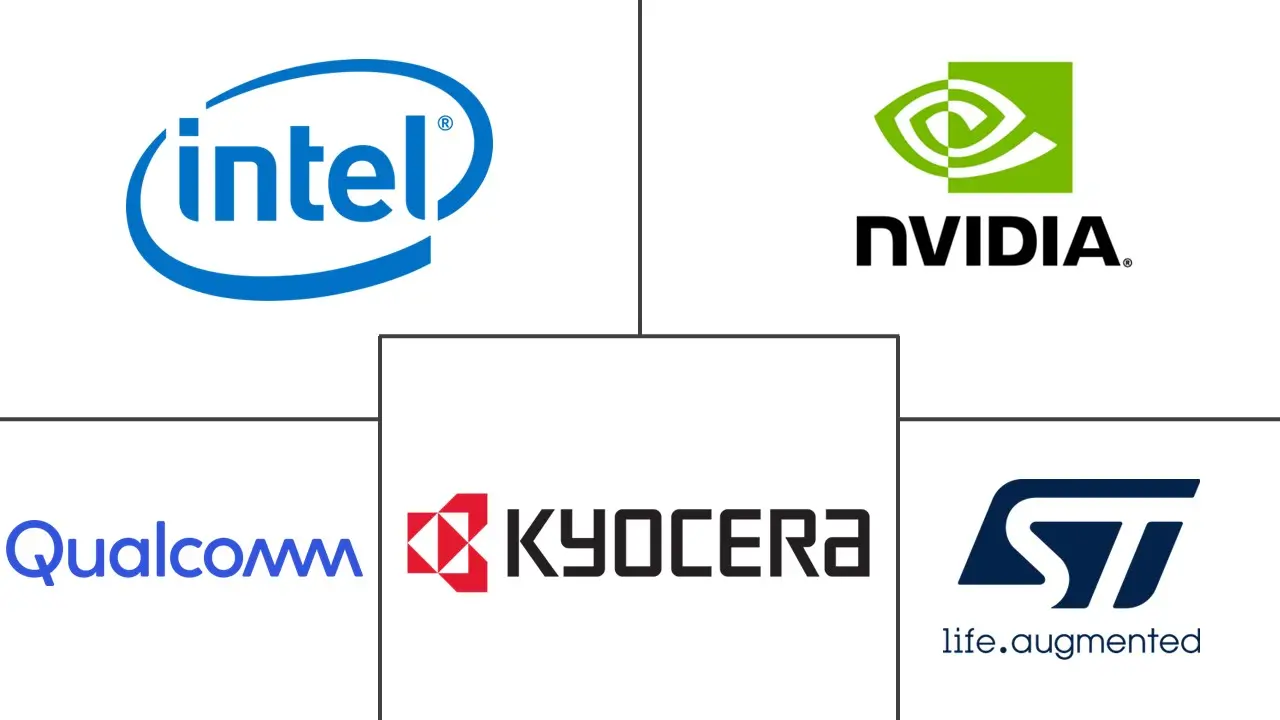Europe Semiconductor Device Market Size
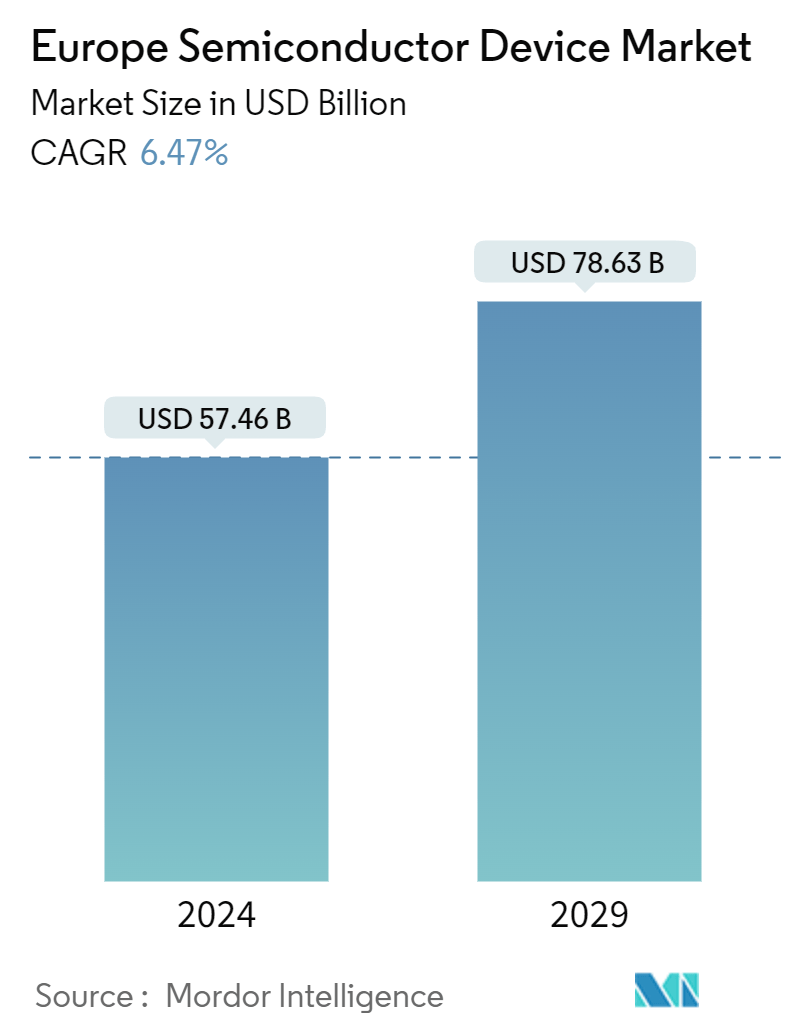
| Study Period | 2019 - 2029 |
| Base Year For Estimation | 2023 |
| Market Size (2024) | USD 57.46 Billion |
| Market Size (2029) | USD 78.63 Billion |
| CAGR (2024 - 2029) | 6.47 % |
| Market Concentration | Low |
Major Players*Disclaimer: Major Players sorted in no particular order |
Europe Semiconductor Device Market Analysis
The Europe Semiconductor Device Market size is estimated at USD 57.46 billion in 2024, and is expected to reach USD 78.63 billion by 2029, growing at a CAGR of 6.47% during the forecast period (2024-2029).
- Semiconductor devices play a pivotal role in a wide array of electronic devices, spanning from smartphones, LED TVs, and flat-screen monitors to applications in civil aerospace and military systems. Advancements in biometrics are poised to further bolster this sector. Europe's increasing appetite for smartphones and cutting-edge products, including wearables, is notably influencing the market's trajectory.
- During the forecast period, the European semiconductor industry is poised for robust growth. This growth is driven by the escalating demand for semiconductor materials in cutting-edge technologies like artificial intelligence (AI), autonomous driving, 5G, and the Internet of Things. This surge is further fueled by heightened competition among industry players and a consistent focus on R&D.
- For instance, the automotive industry's shift toward automation and electrification is significantly boosting the demand for semiconductor devices. These devices, embedded with diverse functionalities, are integral to automotive components like infotainment systems, navigation controls, and collision detection mechanisms. The integration of such advanced features is directly influencing automobile sales.
- The rising adoption of data-intensive IoT devices, alongside the emergence of markets like Industry 4.0, wearables, aviation, healthcare, smart homes, and more, is further bolstering the demand for semiconductor devices.
- Europe's semiconductor market is bolstered by a favorable government stance. Notably, the European Commission, addressing chip shortage worries, initiated the ambitious 'Chips Act.' This plan aims to elevate Europe's semiconductor production share, targeting a doubling by 2030. These initiatives are poised to create significant market opportunities in the coming years.
- However, this market grapples with notable challenges that impede its progress. Notably, the integrated circuits (ICs) segment's rising complexity poses a substantial hurdle. The manufacturing and development of cutting-edge semiconductor devices come with a hefty price tag. This is primarily due to intricate manufacturing processes, the imperative of miniaturization, and the demand for specialized materials and equipment. Consequently, these high production costs directly influence semiconductor pricing, rendering them less accessible to smaller enterprises and cost-conscious consumers.
- The semiconductor supply crisis, initially sparked by the pandemic and further exacerbated by unpredictable geopolitical tensions, has prompted nations across the region to reassess their manufacturing strategies. Recognizing semiconductors as pivotal to economic growth and the well-being of their citizens, the European Commission, in collaboration with other European nations, has unveiled an ambitious initiative. This initiative seeks to ramp up semiconductor production within Europe, with the overarching goals of bolstering the continent's technological independence, enhancing its competitiveness and resilience, and supporting its digital and green transformations.
Europe Semiconductor Device Market Trends
Communication Sector to be the Fastest Growing End-user Vertical
- Semiconductors are pivotal in communication systems, facilitating the production of essential components such as transistors, diodes, and integrated circuits. These components are instrumental in signal processing, amplification, and modulation. Wired communication devices encompass Ethernet controllers, adapters, and switches, alongside Power over Ethernet (PoE) interface controllers tailored for Voice over Internet Protocol (VoIP) and powerline transceivers. Traditionally, copper, known for its electrical conductivity, dominated telephone line materials. The industry is pivoting toward fiber optics to bolster bandwidth. Fiber optic technology is crafted from various semiconductors, including photodetectors and LEDs.
- In wireless communication, semiconductors are used in microwave, infrared, satellite, broadcast radio, mobile communications systems, Wi-Fi, and technologies such as Bluetooth and Zigbee. System-on-chip (SoC) and field-programmable gate array (FPGA) devices drive the evolution of wireless communication systems, notably 5G. Meanwhile, low-energy microcontrollers (MCUs) are pivotal in enhancing Bluetooth functionalities.
- Wireless sensor networks find applications in diverse fields, from environmental and structural monitoring to asset tracking. Furthermore, with the rapid advancement of communication technologies, wireless applications are poised to expand and redefine how consumers communicate, bolstering market growth both presently and in the future.
- According to ETNO, the total cumulative investment in FTTH is expected to surge to EUR 83.1 billion (USD 78.85 billion) by 2025, with an annual investment of EUR 10.1 billion (USD 10.90 billion). Such ongoing investments in high-speed fiber optic broadband networks across Europe drive the demand for semiconductor devices. These devices include optical transceivers, photonic integrated circuits, and signal processing chips, which are crucial for fiber optic communication equipment.
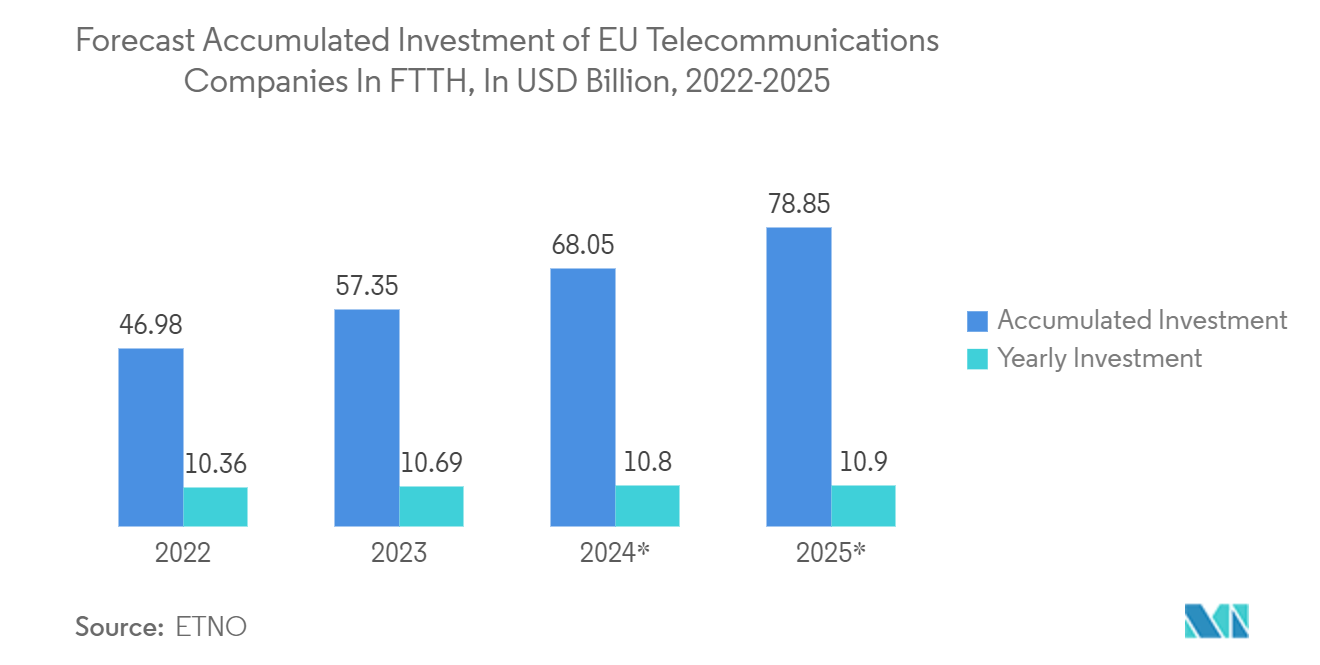
France Expected to Witness Major Growth
- The "France 2030" plan, designed to bolster the nation's industrial sovereignty, particularly in sectors like semiconductors, is a cornerstone of France's strategic vision. French companies are tapping into public aid programs, notably the European IPCEI ME/CT initiative, to fortify their production and research capabilities. Moreover, France is leveraging EU initiatives, such as the Chips Act, to ramp up semiconductor production across Europe.
- In a bid to spearhead semiconductor R&D, the French Government has upped its financial backing for research institutions and universities with a keen eye on next-gen technologies.
- Notably, CEA-Leti, a prominent nonprofit semiconductor research entity in France, plays a pivotal role in bridging the gap between theoretical research and practical industry applications. Similar organizations dotting Europe include Belgium's IMEC, Finland's VTT Technical Research Center, Germany's Fraunhofer Society, and Spain's Tecnalia. It's worth noting that CEA-Leti operates under the umbrella of a larger governmental body, the French Alternative Energies and Atomic Energy Commission (CEA).
- The automotive sector is a major driver of the semiconductor demand in France. With the French Government's push for a greener economy and the EU's stringent emission regulations, automakers are increasingly integrating advanced semiconductor technologies into EVs and hybrid vehicles. According to data published by OICA, 1.5 million cars were manufactured in France in 2023. This marked a continuous increase since 2020, after a drastic fall in 2019.
- Moreover, as per Avere France data, 328,512 electric cars were registered in France in 2023. This represents a significant increase from the 2022 level and an upward trajectory since 2011. Between 2019 and 2020, BEV registrations more than doubled.
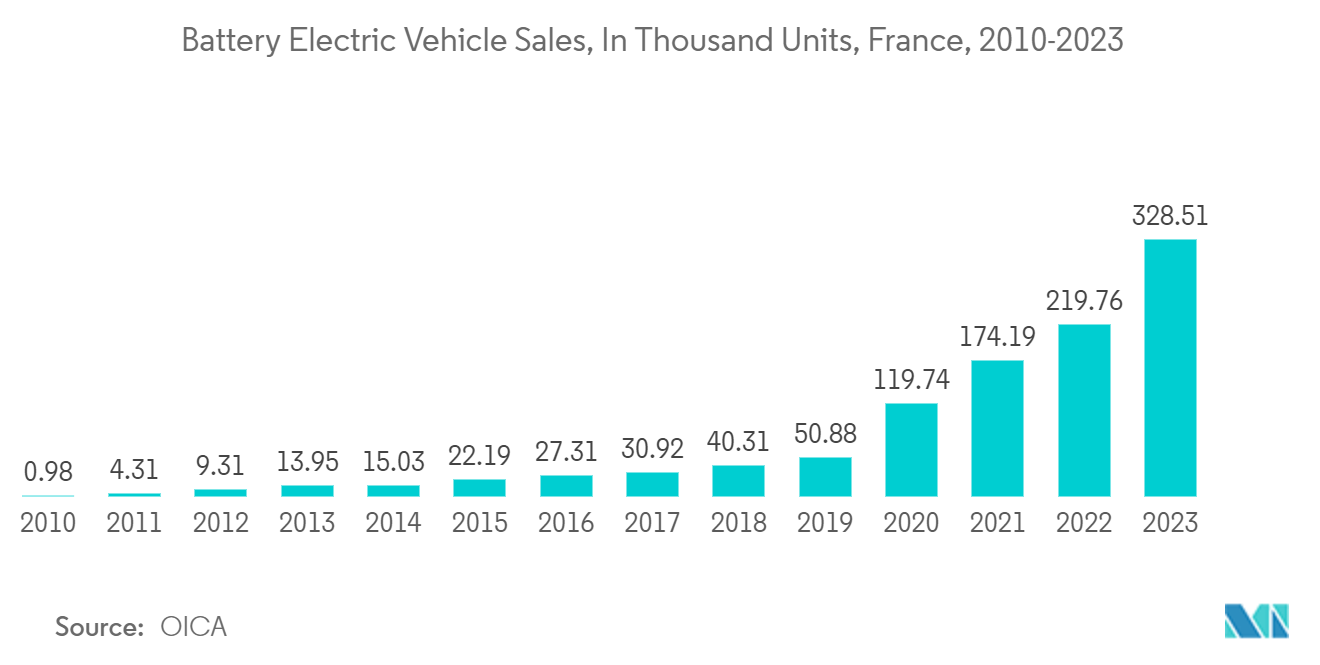
Europe Semiconductor Device Industry Overview
The European semiconductor device market is fragmented. Large market incumbents, such as Intel Corporation, Nvidia Corporation, Kyocera Corporation, Qualcomm Technologies Inc., and STMicroelectronics NV, are present, and as foundries and IDMs increasingly vertically integrate, the market faces heightened competition. This competition is fueled by their robust revenue streams, enabling them to make substantial investments.
- February 2024 - Intel Corporation unveiled Intel Foundry, a sustainable systems foundry tailored for the AI era. It revealed an extended process roadmap, aiming to solidify their leadership well into the 2030s. The company emphasized strong customer backing and ecosystem support, with key partners like Synopsys, Cadence, Siemens, and Ansys, all geared to expedite chip design for Intel Foundry's clientele through advanced tools and design flows.
- January 2024 - At CES 2024, Qualcomm Technologies Inc. and Robert Bosch GmbH introduced the first central vehicle computer capable of running infotainment and advanced driver assistance system (ADAS) functionalities on one single system-on-chip (SoC). Built on Qualcomm Technologies' leadership in digital cockpit and ADAS compute platforms, the Flex SoC is designed to support mixed-criticality workloads, allowing for digital cockpit, ADAS, and automated driving (AD) capabilities to be co-implemented on a single SoC.
Europe Semiconductor Device Market Leaders
-
Intel Corporation
-
Nvidia Corporation
-
STMicroelectronics NV
-
Kyocera Corporation
-
Qualcomm Incorporated
*Disclaimer: Major Players sorted in no particular order
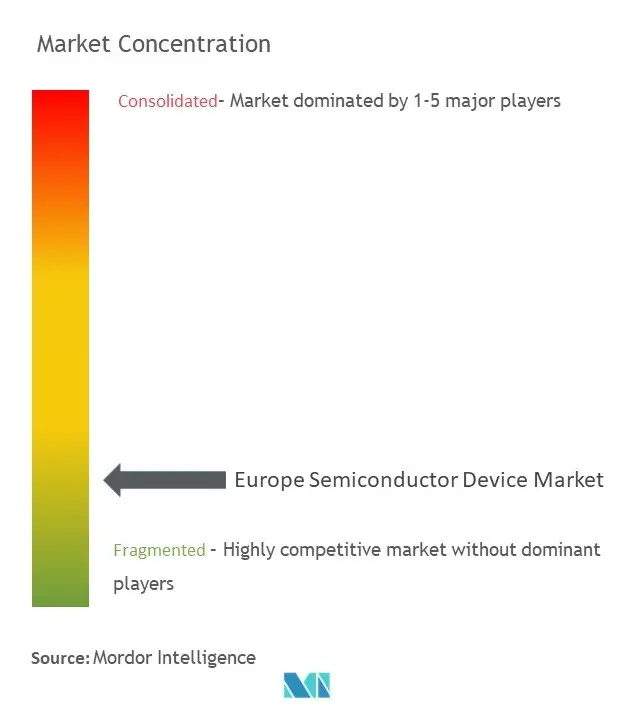
Europe Semiconductor Device Market News
- January 2024 - Intel introduced its latest offering, the Intel Core 14th Gen mobile processor family. Spearheading this release is the flagship Intel Core i9-14900HX, boasting an impressive 24 cores and promising the pinnacle of mobile experiences for enthusiasts. Intel rolled out its full range of Intel Core 14th Gen desktop processors, available in both 65-watt and 35-watt configurations. These processors cater to a broad spectrum of devices, from mainstream desktops to all-in-one and edge devices.
- January 2024 - NVIDIA announced the GeForce RTX 40 SUPER Series family of GPUs, including the GeForce RTX 4080 SUPER, GeForce RTX 4070 Ti SUPER, and GeForce RTX 4070 SUPER, which supercharges the latest games and forms the core of AI-powered PCs. This newest iteration of NVIDIA Ada Lovelace architecture-based GPUs delivers up to 52 shader TFLOPS, 121 RT TFLOPS, and 836 AI TOPS to supercharge gaming and provide the power to develop new entertainment worlds and experiences.
Europe Semiconductor Device Market Report - Table of Contents
1. INTRODUCTION
- 1.1 Study Assumptions and Market Definition
- 1.2 Scope of the Study
2. RESEARCH METHODOLOGY
3. EXECUTIVE SUMMARY
4. MARKET INSIGHTS
- 4.1 Market Overview
- 4.2 Technological Trends
- 4.3 Industry Value Chain Analysis
- 4.4 Assessment of the Impact of Macroeconomic Trends on the Market
-
4.5 Industry Attractiveness - Porter's Five Forces Analysis
- 4.5.1 Bargaining Power of Suppliers
- 4.5.2 Bargaining Power of Buyers
- 4.5.3 Threat of New Entrants
- 4.5.4 Threat of Substitutes
- 4.5.5 Intensity of Competitive Rivalry
5. MARKET DYNAMICS
-
5.1 Market Drivers
- 5.1.1 Growing Adoption of Technologies like IoT and AI
- 5.1.2 Rising Demand for Consumer Electronics Goods
-
5.2 Market Challenges
- 5.2.1 High Competition in The Semiconductor Manufacturing Market
6. MARKET SEGMENTATION
-
6.1 By Device Type
- 6.1.1 Discrete Semiconductors
- 6.1.2 Optoelectronics
- 6.1.3 Sensors and Actuators
- 6.1.4 Integrated Circuits
- 6.1.4.1 Analog
- 6.1.4.2 Logic
- 6.1.4.3 Memory
- 6.1.5 Micro
- 6.1.5.1 Microprocessors (MPU)
- 6.1.5.2 Microcontrollers (MCU)
- 6.1.5.3 Digital Signal Processors
-
6.2 By End-user Vertical
- 6.2.1 Automotive
- 6.2.2 Communication (Wired and Wireless)
- 6.2.3 Consumer
- 6.2.4 Industrial
- 6.2.5 Computing/Data Storage
- 6.2.6 Other End Users
-
6.3 By Country***
- 6.3.1 Germany
- 6.3.2 United Kingdom
- 6.3.3 France
7. COMPETITIVE LANDSCAPE
-
7.1 Company Profiles*
- 7.1.1 Intel Corporation
- 7.1.2 Nvidia Corporation
- 7.1.3 Kyocera Corporation
- 7.1.4 Qualcomm Incorporated
- 7.1.5 STMicroelectronics NV
- 7.1.6 Advanced Micro Devices Inc. (Xilinx Inc.)
- 7.1.7 NXP Semiconductors NV
- 7.1.8 Toshiba Electronic Devices and Storage Corporation
- 7.1.9 Samsung Electronics Co. Ltd
- 7.1.10 ON Semiconductor Corporation
- 7.1.11 Infineon Technologies AG
- 7.1.12 Rohm Co. Ltd
- 7.1.13 Analog Devices Inc.
- 7.1.14 Texas Instrument Inc.
- 7.1.15 Arm Holdings PLC
- 7.1.16 Wolfspeed Inc.
- 7.1.17 ams Osram AG
8. INVESTMENT ANALYSIS
9. FUTURE OUTLOOK OF THE MARKET
** Subject To AvailablityEurope Semiconductor Device Industry Segmentation
Semiconductor devices are among the core components of electronic devices/systems and enable advancements in communications, computing, transportation, and countless other applications in the scope of industries. A wide variety of semiconductor devices are used in today’s industrial, commercial, and residential applications, including discrete semiconductors, optoelectronic devices, and integrated circuits. The market is defined by the revenue generated through the sales of semiconductor devices like sensors, discrete semiconductors, optoelectronics, integrated circuits, etc., by major market vendors in Europe.
The Europe Semiconductor device market is segmented by device type (discreet semiconductors, optoelectronics, sensors and actuators, integrated circuits [analog, logic, memory], micro [microprocessors (MPU), microcontrollers (MCU), digital signal processors]), by end-user vertical (automotive, communication [wired and wireless], consumer, industrial, computing/data storage, other end users), and country (Germany, United Kingdom, France, Rest of Europe). The report offers market forecasts and size in value (USD) for all the above segments.
| By Device Type | Discrete Semiconductors | |
| Optoelectronics | ||
| Sensors and Actuators | ||
| Integrated Circuits | Analog | |
| Logic | ||
| Memory | ||
| Micro | Microprocessors (MPU) | |
| Microcontrollers (MCU) | ||
| Digital Signal Processors | ||
| By End-user Vertical | Automotive | |
| Communication (Wired and Wireless) | ||
| Consumer | ||
| Industrial | ||
| Computing/Data Storage | ||
| Other End Users | ||
| By Country*** | Germany | |
| United Kingdom | ||
| France |
Europe Semiconductor Device Market Research Faqs
How big is the Europe Semiconductor Device Market?
The Europe Semiconductor Device Market size is expected to reach USD 57.46 billion in 2024 and grow at a CAGR of 6.47% to reach USD 78.63 billion by 2029.
What is the current Europe Semiconductor Device Market size?
In 2024, the Europe Semiconductor Device Market size is expected to reach USD 57.46 billion.
Who are the key players in Europe Semiconductor Device Market?
Intel Corporation, Nvidia Corporation, STMicroelectronics NV, Kyocera Corporation and Qualcomm Incorporated are the major companies operating in the Europe Semiconductor Device Market.
What years does this Europe Semiconductor Device Market cover, and what was the market size in 2023?
In 2023, the Europe Semiconductor Device Market size was estimated at USD 53.74 billion. The report covers the Europe Semiconductor Device Market historical market size for years: 2019, 2020, 2021, 2022 and 2023. The report also forecasts the Europe Semiconductor Device Market size for years: 2024, 2025, 2026, 2027, 2028 and 2029.
Europe Semiconductor Device Industry Report
Statistics for the 2024 Europe Semiconductor Device market share, size and revenue growth rate, created by Mordor Intelligence™ Industry Reports. Europe Semiconductor Device analysis includes a market forecast outlook to for 2024 to 2029 and historical overview. Get a sample of this industry analysis as a free report PDF download.

